
If you’ve ever felt stuck in endless learning cycles, unsure if you’ll ever feel ready, you may be caught in the Expert Trap, a core pattern of imposter syndrome that quietly affects many high-achievers.
You might recognize these thoughts:
“I’ll feel ready once I take one more course.”
“I just need to research it a bit more before I speak up.”
“If I make a mistake, everyone will realize I’m not as competent as they think.”
If these thoughts sound familiar, you may be caught in the Expert Trap, one of the most subtle ways imposter syndrome shows up for quiet, high-achieving professionals.
For many high-achievers, the fear of being unprepared fuels endless learning. More courses. More certifications. More late-night reading. It feels productive, but often it’s protection in disguise.
For quiet high-achievers especially, knowledge can become a kind of armor, a way to feel safe in unpredictable workplaces and relationships. But over time, that armor becomes a cage.
What the Expert Trap Is
The Expert Trap is one of the core patterns of imposter syndrome, the belief that confidence must be earned through mastery. You chase certainty before allowing visibility.
At its core, this isn’t arrogance; it’s anxiety wearing professionalism.
Common thoughts include:
“I should already know this.”
“If I don’t have every answer, I’ll lose credibility.”
“Once I master everything, then I can relax.”
But that finish line keeps moving. Underneath the drive to know more is something tender, a fear of being wrong, rejected, or exposed as inadequate.
Attachment and developmental research suggests this pattern often forms when early praise was conditional (i.e., tied exclusively to achievement) or when mistakes led to criticism, shame, or emotional withdrawal. Over time, the nervous system learns: safety means being right, not being yourself.
I know this pattern well because I’ve lived it too. As a recovering Expert, I’ve often found myself thinking, “Maybe I need one more training or certification before I’m truly ready.” It’s a hard one to untangle because continual growth and self-improvement can look identical on the surface.
But they come from very different places. Growth comes from curiosity and expansion. The Expert Trap comes from the fear that you are not enough yet. The truth is, you are enough and you can keep growing. Both can coexist.
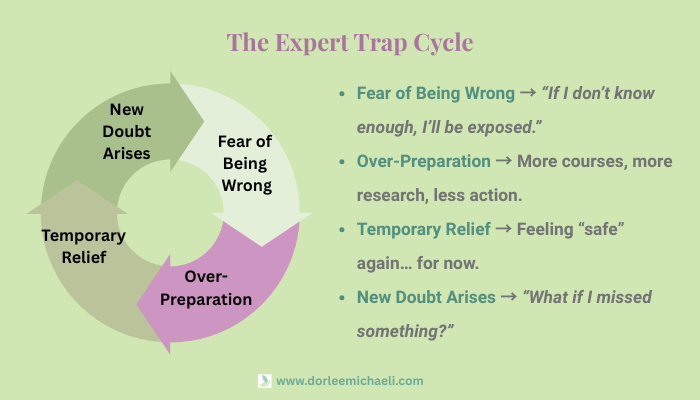
How the Expert Trap imposter syndrome Shows Up
Because it looks like diligence, this pattern is often rewarded. Still, the cost is quiet exhaustion.
You may notice yourself:
Taking course after course but hesitating to apply what you’ve learned.
Over-preparing before meetings or presentations.
Holding back ideas until you’ve checked every detail.
Avoiding delegation because “no one else will do it right.”
Feeling fraudulent when you can’t answer immediately.
Real-world snapshots:
A software engineer who won’t submit code for review until it’s “perfect.”
A physician who rereads literature until midnight to be sure she hasn’t missed anything.
A financial analyst who triple-checks spreadsheets long after accuracy is confirmed.
“I’d rather stay late and get it perfect than risk someone thinking I missed something.”
Outwardly, you appear reliable. Inwardly, you live in quiet hyper-vigilance.
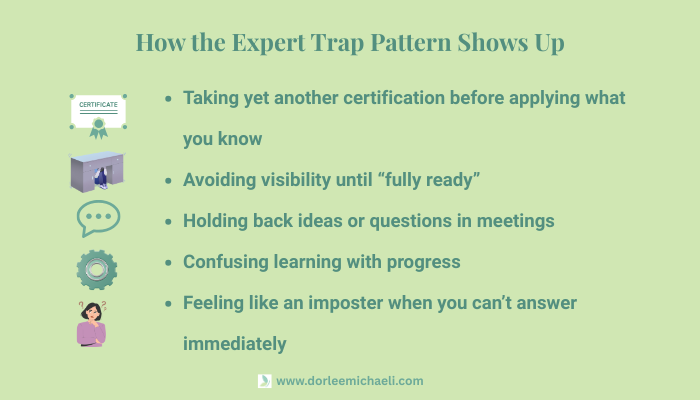
When Preparation Becomes Protection
Sarah, a data scientist with a decade of experience, delayed applying for a leadership role for two years. Her reason? “I’m not expert enough in Python yet.”
In therapy, she traced that fear to a specific memory: a graduate-school professor who ridiculed her code in front of her peers. Even years later, her body still braced for humiliation whenever she faced visibility without “perfect” preparation.
Through EMDR, she reprocessed that formative moment: the shame, the helplessness, the decision to never be caught unprepared again. As the emotional charge diminished, something shifted: she could finally separate that professor’s cruelty from her actual capability.
She applied and got the promotion. Now she mentors others who doubt themselves, teaching what she learned: competence doesn’t require omniscience.
The Nervous System of the Expert
Neurobiologically, the Expert Trap functions as control-based safety. When early experiences linked uncertainty with criticism or shame, the body learned that knowledge equals protection.
Each time you study harder, your brain releases a small dose of calm, proof that you’re “safe again.” However, it’s temporary. The next unknown reignites alarm.
Trauma research (van der Kolk, 2014) and polyvagal theory (Porges, 2011) show that our sense of safety depends less on logic and more on how our bodies interpret threat. EMDR and other trauma-informed therapies help reprocess those early moments so learning feels expansive rather than defensive.
How to Begin Releasing the Expert Trap and imposter syndrome
You don’t need to abandon excellence. Instead, the work is learning to trust that confidence can coexist with uncertainty.
Healing the Expert Trap imposter syndrome pattern starts with learning to trust yourself even when you don’t feel fully ready.
1. Redefine What Expertise Means
True expertise isn’t omniscience; it’s curiosity, humility, and adaptability.
True mastery includes room for growth.
Ask yourself: Can being human be part of being skilled?
2. Adopt a Growth Mindset
Research by psychologist Carol Dweck shows that people who hold a growth mindset, the belief that ability develops through effort and feedback, learn faster and recover more easily from mistakes.
Try shifting from “I should already know this” to “I’m still learning this.”
This simple reframe moves you from proving your worth to expanding it, freeing you from the endless loop of needing to know more before you can act. (Dweck, C. S., 2006)
3. Notice When Learning Becomes Avoidance
Before enrolling in another course, pause: “What am I afraid might happen if I don’t?”
If the answer involves judgment or exposure, you’re protecting, not progressing.
4. Practice Imperfect Action
Speak up before you feel 100 percent ready.
Send the draft. Volunteer the idea.
Confidence doesn’t precede action; it grows from it.
Reflection: What’s one situation this week where you could speak up or act before you feel fully prepared?
5. Balance Learning with Doing
Ask: “What can I learn only by trying?”
Progress, not preparation, is the real teacher.
6. Reclaim Rest as Intelligence
Over-learning often masks anxiety. Integration and rest solidify growth more than nonstop input.
7. Bring Compassion to the Part Protecting You
That inner Expert is trying to keep you safe.
You can thank it and gently remind it that confidence doesn’t require certainty.
Healthy Learning vs. The Expert Trap
There are times when deep study is essential such as in changing careers, earning a license, or entering new domains. The difference lies in how it feels:
Healthy Learning
Feels expansive and energizing
Is motivated by curiosity and growth
Builds confidence over time
Is balanced with rest and integration
Expert Trap
Feels contracting and exhausting
Is driven by fear of exposure
Fuels ongoing anxiety
Demands constant control
True expertise thrives on curiosity, not control.
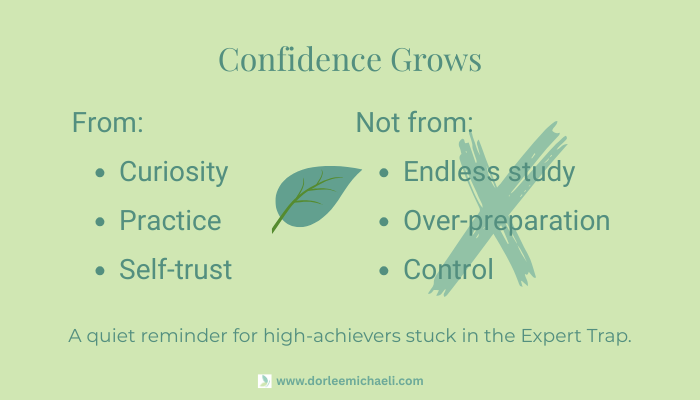
How to Begin Releasing the Expert Trap
You don’t need to abandon excellence. The work is learning to trust that confidence can coexist with uncertainty.
Healing the Expert Trap imposter syndrome pattern starts with learning to trust yourself even when you don’t feel fully ready.
Redefine What Expertise Means
True expertise isn’t omniscience; it’s curiosity, humility, and adaptability.
True mastery includes room for growth.
Ask yourself: Can being human be part of being skilled?
2. Adopt a Growth Mindset
Research by psychologist Carol Dweck shows that people who hold a growth mindset, the belief that ability develops through effort and feedback, learn faster and recover more easily from mistakes.
Try shifting from “I should already know this” to “I’m still learning this.”
This simple reframe moves you from proving your worth to expanding it, freeing you from the endless loop of needing to know more before you can act. (Dweck, C. S., 2006)
3. Notice When Learning Becomes Avoidance
Before enrolling in another course, pause: “What am I afraid might happen if I don’t?”
If the answer involves judgment or exposure, you’re protecting, not progressing.
4. Practice Imperfect Action
Speak up before you feel 100 percent ready.
Send the draft. Volunteer the idea.
Confidence doesn’t precede action; it grows from it.
Reflection: What’s one situation this week where you could speak up or act before you feel fully prepared?
Healing the Expert Trap
In EMDR and other trauma-informed therapy, clients often revisit the first moments when being wrong felt dangerous (a teacher’s sigh, a parent’s silence, a manager’s glare). When those memories are integrated, the body stops confusing uncertainty with threat.
Ultimately, confidence begins not with more facts but with a calmer nervous system, one that can tolerate “I don’t know” without panic.
FREQUENTLY ASKED QUESTIONS
Q. Is the Expert Trap Imposter Syndrome the same as perfectionism?
A. No. Perfectionism centers on flawless results while the Expert Trap centers on flawless knowledge.
Q. How do I know if I’m in the Expert Trap or just being thorough?
A. Healthy diligence feels steady. The Expert Trap feels tense and never “enough.”
Q. Can EMDR help with imposter syndrome?
A. In my clinical experience, yes, especially when imposter feelings are rooted in specific experiences of criticism, shame, or conditional acceptance. EMDR helps reprocess those formative moments when mistakes felt dangerous, allowing you to approach uncertainty with greater calm.
Not all imposter syndrome stems from trauma, so assessment is important. But when there’s a “memory behind the fear,” EMDR can be remarkably effective in loosening its grip. (EMDRIA Research Overview)
Q. Is more training ever a good thing?
A. Absolutely. Growth is essential, particularly in evolving fields like tech, finance, and healthcare. The key is whether learning expands or constricts your sense of self.
Q. How can I start breaking this pattern?
A. Notice when your need to “know more” delays visibility. Try one small, safe act of imperfect sharing, and then observe that you’re still safe.
Closing Thoughts and Next Steps
The Expert Trap isn’t a flaw; it’s a survival strategy that once kept you safe. The part of you that keeps studying, preparing, perfecting? It was trying to protect you from an old danger.
The work isn’t abandoning excellence. It’s learning to trust that you can be skilled and uncertain, knowledgeable and still learning, visible and safe—all at once.
You don’t have to know everything to belong. You just have to let yourself be seen – uncertain, learning, and still deeply valuable.
That’s where real confidence begins.
📚 Imposter Syndrome Series
This post is Part 5 of my Imposter Syndrome Series for quiet, high-achieving professionals.
References/Further Reading
If you’d like to go deeper, these books and studies offer thoughtful insights into how imposter syndrome, perfectionism, and trauma intersect:
Brown, B. (2012). Daring Greatly. Gotham Books.
Clance, P. R., & Imes, S. A. (1978). The Imposter Phenomenon in High-Achieving Women: Dynamics and Therapeutic Intervention. Psychotherapy: Theory, Research & Practice, 15(3), 241–247.
Dweck, C. S. (2006). Mindset: The New Psychology of Success. Random House.
EMDR International Association (EMDRIA). Research Overview
Grant, A. (2013). Give and Take. Penguin Books.
Neff, K. D. (2003). Self-Compassion and Psychological Well-Being. Self and Identity, 2(3), 223–250.
Porges, S. W. (2011). The Polyvagal Theory. W. W. Norton & Company.
van der Kolk, B. (2014). The Body Keeps the Score. Penguin Books.
Young, V. (2011). The Secret Thoughts of Successful Women. Crown Publishing.
Published: November 2, 2025

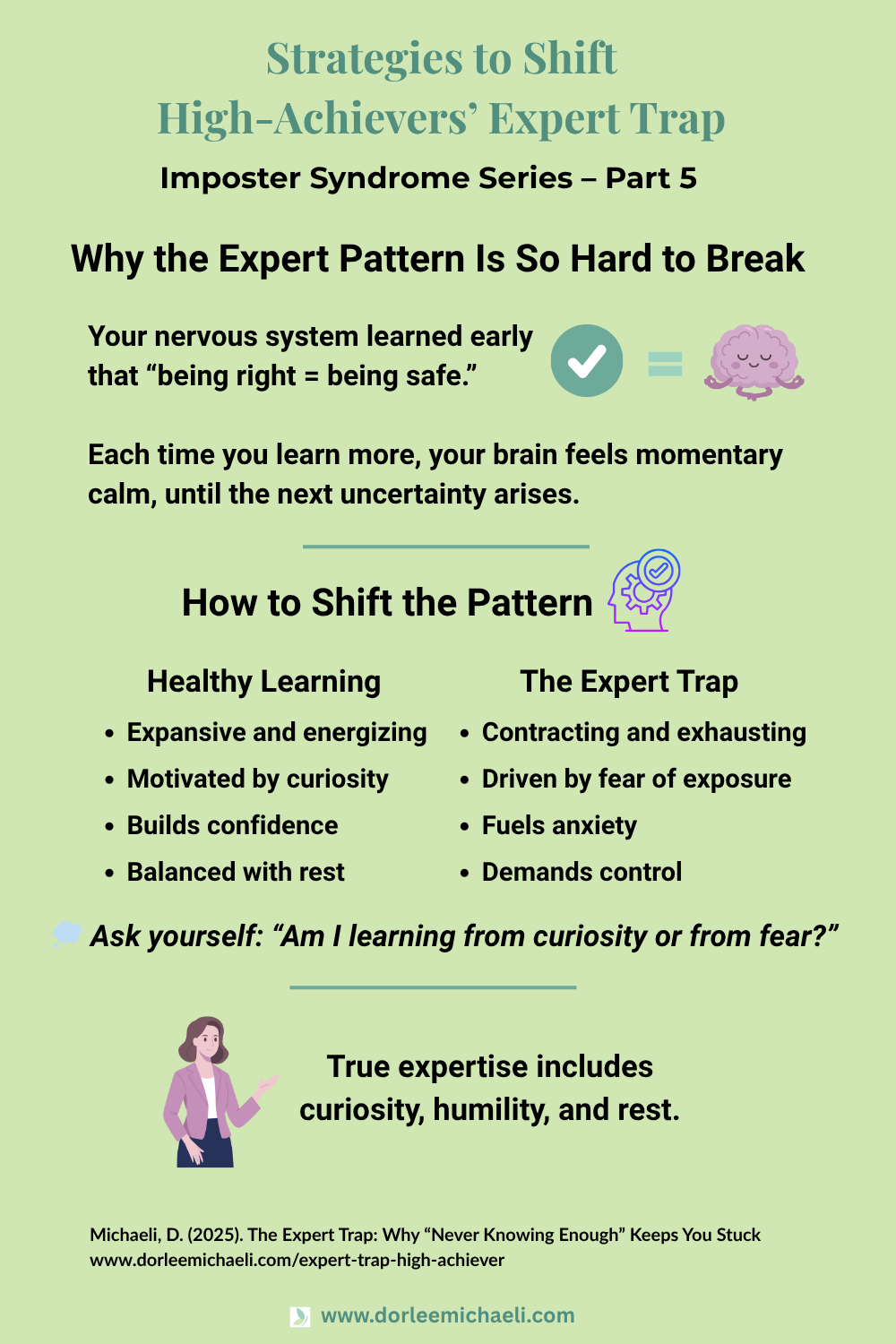





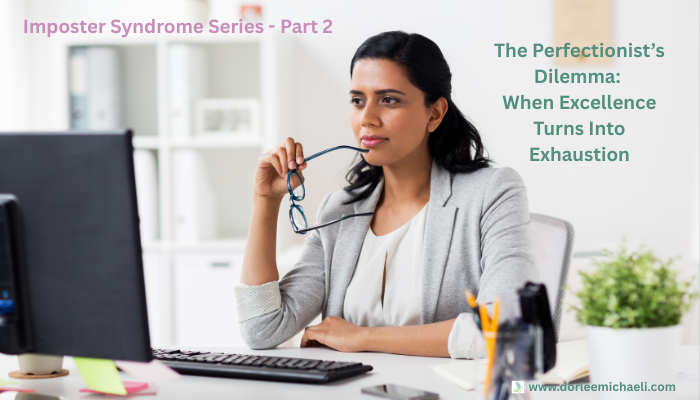
Pingback: The People-Pleaser Pattern & Imposter Syndrome
An excellent exploration of how imposter patterns quietly shape high-achievers. I especially appreciate the integration of developmental and neurobiological insight, a grounded, compassionate take on a universal struggle.
Thanks so much, Heather, for your thoughtful comment. I really appreciate your noting the developmental and neurobiological layers. Those roots are often what make imposter patterns so persistent, even in accomplished people.
Dorlee,
I love this –> “Competence doesn’t require omniscience.”
And, how you emphasize that we don’t need to abandon excellence. The way you reframe our mindset toward ‘growth’ vs. ‘expertise’ is empowering.
Moreover, I like how you encourage practicing imperfect action, and how confidence grows from action. Interestingly, several months ago, I printed and taped the following related quote on my bathroom mirror:
“Action confirms belief.
The man who moves
even while uncertain,
begins to multiply his strength.”
Moreover, Dorlee, your EMDR and other trauma-informed therapies are such a valuable resource to your clients and potential clients, as they seek to convert defensive learning into expansive learning experiences!
What a wealth of intellect, knowledge, experience and tools you offer to high-achieving women seeking to rise with confidence!
Thanks so much for taking the time to share such a meaningful reflection. I love the quote you mentioned: “Action confirms belief…” It beautifully mirrors the heart of this post: that strength grows from movement, not from having every answer first.
And yes, what you said about shifting from defensive learning to expansive learning is exactly the work trauma-informed therapy allows. When the body feels safe, excellence no longer requires self-abandonment, and confidence can grow from trying, not just knowing.
I’m so grateful for your presence in this dialogue, and your enthusiastic support of my work!
Pingback: Why Smart Women Still Feel Like Frauds
Another insightful addition to your series. I really appreciate how you describe the Expert Trap as protection, not a flaw. It’s such a compassionate perspective. Thank you for putting language around something so many high-achievers quietly wrestle with; this will resonate with a lot of people.
Thank you for this kind reflection, Cheryl. I’m so glad the framing of the Expert Trap as protection resonated with you. It’s such an important shift from self-criticism to compassion. Many high-achievers carry these patterns quietly, and naming them can be the first step toward relief and change.
Pingback: Natural Genius Imposter Syndrome: Why “If I Can’t Do It Easily, I’m Failing” Keeps You Stuck
In my experience, Dorlee, the Expert Trap can be a self-imposed limitation that holds us back from pursuing new opportunities or taking on new challenges, and I’ve had to work on building my own confidence and self-trust to overcome the fear of not knowing everything before taking the leap (very challenging as I was brought up to be a perfectionist and high achiever)…
I appreciate you adding this perspective, Cheryl. The Expert Trap can be such a powerful limiter because it ties worth to certainty. For many high achieving women that message gets baked in long before adulthood. What you describe building trust in your judgment instead of waiting for perfect readiness is exactly the shift that frees people to pursue opportunities that match who they are becoming rather than who they felt they had to be. Thank you for articulating it so clearly.